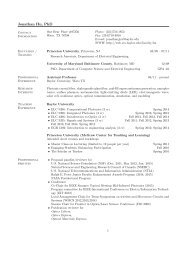Modeling backward-pumped Raman amplifiers - Jonathan Hu ...
Modeling backward-pumped Raman amplifiers - Jonathan Hu ...
Modeling backward-pumped Raman amplifiers - Jonathan Hu ...
Create successful ePaper yourself
Turn your PDF publications into a flip-book with our unique Google optimized e-Paper software.
2088 J. Opt. Soc. Am. B/ Vol. 22, No. 10/ October 2005 <strong>Hu</strong> et al.<br />
the initial choice for the pump powers for the <strong>Raman</strong> iteration<br />
at a new comes from the previous iteration.<br />
4. RESULTS AND COMPARISON<br />
In this section, we compare the run time for the relaxation<br />
and shooting algorithms to solve the two-point<br />
boundary-value problem. As an example, in a system of<br />
length L=50 km with one pump wave and 10 signal<br />
waves, the shooting algorithm is about four times slower<br />
than the relaxation algorithm. For a system with eight<br />
pump waves and 100 signal waves, the shooting algorithm<br />
is about nine times slower than the relaxation algorithm.<br />
The shooting algorithm is slower because of its<br />
complexity and the extensions required for convergence.<br />
However, as we pointed out, the shooting algorithm is<br />
more flexible in that it can solve the <strong>Raman</strong> equations under<br />
the constraint of specified averaged pump power. In<br />
Fig. 5, we show the convergence of the shooting algorithm<br />
when four pump waves are constrained to have a<br />
distance-averaged power of 20 mW, with 50 signal waves.<br />
The initial guesses to start the shooting algorithm are the<br />
pump output powers at z=0 that give 20 mW average<br />
Fig. 6. Convergence of the shooting algorithm with the constraint<br />
that the averaged pump power equals 20 mW for eight<br />
pump waves and 100 signal waves. The pump waves are equally<br />
spaced between 1430 and 1490 nm. The signal waves are equally<br />
spaced between 1525 and 1605 nm with an input power of<br />
−3 dBm per channel. (a) Average input pump power as a function<br />
of iteration number. (b) Input pump power at z=L as a function<br />
of iteration number.<br />
Fig. 5. Convergence of the shooting algorithm with the constraint<br />
that the averaged pump power equals 20 mW for four<br />
pump waves with 50 signal waves. The pump waves are equally<br />
spaced between 1437 and 1462 nm. The signal waves are equally<br />
spaced between 1530 and 1570 nm with an input signal power of<br />
−3 dBm per channel. (a) Average input pump power as a function<br />
of iteration number. (b) Input pump power at z=L as a function<br />
of iteration number.<br />
pump power if the pump waves experience only the fiber<br />
loss. Note that as the average pump powers converge to<br />
the same value shown in Fig. 5(a), the input pump powers<br />
at z=L converge to different values shown in Fig. 5(b), because<br />
of pump-to-pump and pump-to-signal interactions.<br />
In this simulation, the 50 signal waves are spaced equally<br />
between 1530 and 1570 nm with an input signal power of<br />
−3 dBm per channel. The output signal powers are between<br />
−10 and −5.8 dBm. The pump waves are spaced<br />
equally between 1437 and 1462 nm. From the simulation,<br />
we obtain input pump powers between 137 mW and 263<br />
mW, as shown in Fig. 5(b). Figure 6 shows the same convergence<br />
for eight pump waves and 100 signal waves for<br />
the same shooting target of 20 mW average pump power.<br />
In this case, the continuation method was used in combination<br />
with the shooting algorithm, since the algorithm<br />
cannot converge for the desired 20 mW shooting target<br />
with the initial guesses for the pumps obtained from the<br />
fiber loss. Therefore the continuation method sets the<br />
shooting target as 10 mW, following the flowchart in<br />
Fig. 4, and after convergence at the fifth iteration, the<br />
shooting target is reset to 20 mW. The initial guess for the<br />
sixth iteration is determined from the converged pump<br />
output power at z=0. In Fig. 6(a), the solid curve with



